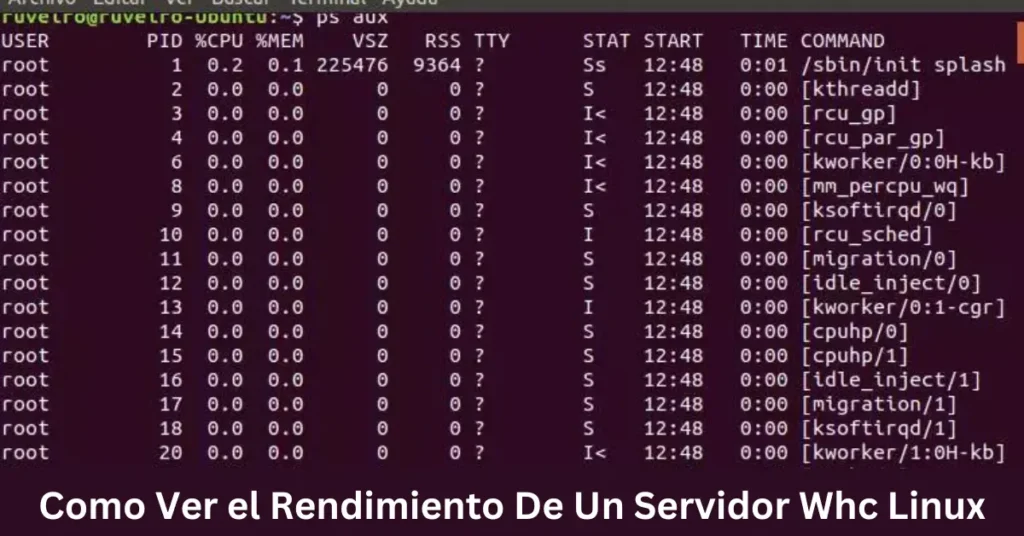Monitoring the performance of a WHC Linux server is crucial for smooth operation, minimizing downtime, and maintaining high-quality service. Como ver el rendimiento de un servidor whc linux. When a server faces strain—whether from high CPU usage, low memory, or network bottlenecks—it can lead to application slowdowns, user experience issues, or even server crashes.
This guide covers simple yet effective methods to check and interpret performance metrics on your WHC Linux server, focusing on CPU usage, memory, disk I/O, and network activity. We’ll discuss essential tools like top and htop, along with more advanced options like Netdata, for real-time insights and reliable monitoring setups. By the end, you’ll have the knowledge and resources to keep your server optimized, resolve issues promptly, and enhance the overall experience for your users.
What Is Como Ver el Rendimiento De Un Servidor Whc Linux?
“Cómo ver el rendimiento de un servidor WHC Linux” is a practical guide to understanding how a server—a specialized computer that stores and transmits information like web pages to multiple users simultaneously—functions. Monitoring essential resources such as CPU, memory, disk space, and network connections is key to keeping the server running seamlessly.
Linux offers various useful tools to check these metrics. Programs like top and htop reveal CPU and memory usage, while netstat monitors network connections, and iotop tracks disk usage. Armed with this information, you can keep the server in peak condition and proactively resolve potential issues before they impact users.
Also Read: Branam Dr Avenue of Roses Portland
Why Monitoring Server Performance is Important
Monitoring the performance of a WHC Linux server is essential for various reasons. It helps maintain efficient operation, ensures a dependable user experience, and addresses potential problems before they worsen. Here are several key points that emphasize its significance:
1. Ensures Smooth Operations
- Regular performance checks allow you to verify that the server is functioning optimally and identify slow processes or applications that may hinder user experience.
2. Prevents Downtime
- By detecting issues like high CPU usage or low memory early, you can avoid server crashes. Keeping the server running smoothly minimizes downtime, ensuring that users can access services without interruptions.
3. Improves Resource Management
- Monitoring tools offer insights into resource utilization, helping optimize performance. This enables better allocation of resources, ensuring that critical applications receive adequate support.
4. Enhances Security
- Observing network activity can reveal unauthorized access attempts or unusual traffic patterns. This proactive strategy allows you to take preventive measures against potential security breaches.
5. Supports Long-Term Planning
- Analyzing performance trends over time assists in future capacity planning. It helps you identify the right time to upgrade hardware or software based on usage patterns.
6. Facilitates Troubleshooting
- When issues arise, performance monitoring provides crucial data for diagnosing problems. This streamlines the process of identifying root causes and implementing effective solutions.
By consistently monitoring server performance, you can ensure that your WHC Linux server operates efficiently, securely, and effectively. Regular checks not only enhance server management but also improve the overall user experience.
Step-by-Step Guide: Cómo Ver el Rendimiento de un Servidor WHC Linux
Monitoring the performance of a WHC Linux server requires using various tools and commands to collect vital information about its operation. Here’s a straightforward guide to help you get started:
Step 1: Access Your Server
- Log in to Your Server: Use an SSH client like PuTTY (for Windows) or the terminal (for macOS/Linux) to connect to your WHC Linux server.
- Command: ssh username@server_ip_address
Step 2: Use Basic Monitoring Commands
Check CPU and Memory Usage with top
- Type top in the terminal and press Enter. This command provides real-time information about CPU usage, memory, and active processes. Look for CPU percentages and memory usage to see if the server is under heavy load.
Use htop for Enhanced Monitoring
- If htop is installed, simply type htop in the terminal. It offers a more user-friendly and visually appealing display than top, making it easier to interpret data. Use the arrow keys to navigate through processes and view detailed information.
Step 3: Analyze Disk Usage
Check Disk Space with df
- Run the command df -h to view the available disk space on your server. Check the percentage of disk space used to ensure there’s enough space for applications and data.
Monitor Disk I/O with iotop
- If iotop is not already installed, you can install it using the command:
- sudo apt install iotop (for Debian/Ubuntu) or sudo yum install iotop (for CentOS).
- Run iotop to see real-time disk I/O statistics and identify which processes are using the most disk resources.
Step 4: Check Network Activity
Use netstat to Monitor Connections
- Execute the command netstat -tuln to view active connections and listening ports. This will help you identify any unwanted connections or unusual traffic patterns.
Review Network Performance with ping
- Use ping google.com to check the response time to another server or website. This command assesses network latency and connectivity.
Step 5: Gather Long-Term Statistics
Install and Use sar for Historical Data
- To install the sysstat package, which includes sar, use:
- sudo apt install sysstat or sudo yum install sysstat.
- Run sar -u for CPU usage statistics, sar -r for memory statistics, and sar -d for disk activity over time.
Consider Using Netdata for Visual Monitoring
- Netdata offers a web-based interface for real-time monitoring. Follow the official installation guide to set it up on your server. Once installed, access it through your browser to visualize performance metrics.
Step 6: Regularly Review and Optimize
Analyze the Data
- Regularly review the data collected from these commands to identify patterns or recurring issues. Optimize server performance based on your findings, such as upgrading resources or adjusting configurations.
By following these steps, you can effectively monitor the performance of your WHC Linux server, ensuring it operates smoothly and efficiently.
Advantages and Disadvantages of Monitoring WHC Linux Server Performance
Monitoring the performance of a WHC Linux server provides numerous benefits, but it also poses certain challenges. Here’s an overview of the main advantages and disadvantages:
| Advantages |
| Proactive Problem Detection Monitoring tools allow for the early identification of potential issues, such as excessive CPU usage or insufficient memory, before they develop into major problems. This proactive strategy helps maintain uptime and reliability. |
| Improved Resource Management Regular performance monitoring offers insights into how server resources are being utilized. This enables administrators to allocate resources more efficiently, ensuring that essential applications operate smoothly without interruption. |
| Enhanced Security By tracking network activity and connections, you can quickly identify unauthorized access attempts or unusual traffic patterns. This allows for immediate action to prevent security breaches. |
| Data-Driven Decision Making Performance metrics provide valuable data that can inform infrastructure upgrades and capacity planning. Understanding usage trends helps organizations anticipate future requirements. |
| Simplified Troubleshooting When problems arise, monitoring data can aid in diagnosing issues rapidly. Detailed performance logs make it easier to identify the root causes of system failures. |
| Disadvantages |
| Complexity of Setup and Maintenance Implementing monitoring tools can be complicated, particularly for those unfamiliar with Linux systems. Additionally, maintaining these tools and ensuring proper configuration requires ongoing effort and technical know-how. |
| Resource Consumption Some monitoring tools may themselves consume server resources, potentially affecting performance. This is especially significant for servers with limited resources, where every bit of processing power is critical. |
| Overwhelming Data Monitoring systems can generate a large volume of data, making it difficult for administrators to sift through and pinpoint actionable insights. Without appropriate analysis tools or skills, important information may be overlooked. |
| False Positives Monitoring systems can occasionally report non-critical issues, leading to unnecessary alerts and distractions. This can result in alert fatigue, where administrators become desensitized to notifications. |
| Cost of Advanced Tools While many basic monitoring tools are available for free, advanced solutions that offer enhanced features may come with associated costs. Organizations need to evaluate the benefits against the required investment. |
While monitoring the performance of a WHC Linux server offers significant advantages for maintaining system health and security, it also presents challenges that necessitate careful management and planning.
Conclusión
Monitorear el rendimiento de un servidor WHC Linux es fundamental para garantizar su eficiencia y seguridad. Utilizando herramientas como top, htop e iotop, puedes identificar problemas antes de que se conviertan en fallos graves. Esto no solo mejora la experiencia del usuario, sino que también optimiza la gestión de recursos y facilita la toma de decisiones informadas sobre el servidor. Con un monitoreo regular, podrás mantener tu servidor en condiciones óptimas, asegurando un funcionamiento fluido y confiable.
Recuerda que, aunque la configuración inicial puede parecer compleja, hay numerosos recursos y guías disponibles para ayudarte en el proceso. ¡Empieza a monitorear tu servidor hoy y disfruta de un rendimiento superior!
Bonus Point
- Establece Alertas: Configura alertas en tus herramientas de monitoreo para recibir notificaciones automáticas cuando los recursos del servidor lleguen a niveles críticos. Esto te permitirá actuar con rapidez y evitar que los problemas se agraven.
- Realiza Auditorías Periódicas: Programa auditorías de rendimiento regulares para revisar las métricas y ajustar la configuración del servidor según sea necesario. Esto te ayudará a identificar tendencias a largo plazo que podrían no ser evidentes con un monitoreo diario.
- Optimiza tus Aplicaciones: Asegúrate de que las aplicaciones que corren en tu servidor estén optimizadas para utilizar los recursos de manera eficiente. Pequeños ajustes en la configuración de la aplicación pueden tener un gran impacto en el rendimiento general.
- Mantén tu Software Actualizado: Verifica que tanto el sistema operativo como las aplicaciones estén siempre actualizados. Las actualizaciones pueden incluir mejoras de rendimiento y correcciones de seguridad cruciales para el funcionamiento del servidor.
- Documenta tus Cambios: Lleva un registro de cualquier modificación que realices en la configuración del servidor o en las aplicaciones. Esto facilitará el seguimiento de lo que funciona y lo que no, ayudando a resolver problemas en el futuro.
- Utiliza Dashboards Visuales: Implementa dashboards visuales para monitorear el rendimiento. Estas herramientas gráficas facilitan la comprensión rápida del estado del servidor y la detección de problemas a simple vista.
- Comparte Resultados con tu Equipo: Comunica los hallazgos de tu monitoreo a otros miembros del equipo. Esto no solo mejora la comprensión del estado del servidor, sino que también puede generar ideas para optimizaciones y mejoras.
Estas prácticas adicionales te ayudarán a optimizar el monitoreo de tu servidor WHC Linux, asegurando que siempre funcione de la mejor manera posible.





